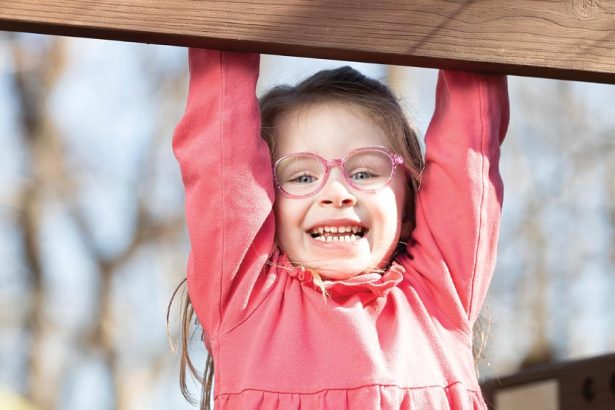Brighter Outlook
April 29, 2022

Landon Ryan. Photo by Erin O. Smith.
If Landon Ryan had been diagnosed with bilateral retinoblastoma 10, 20 or 30 years ago, she might not be here today with nearly perfect vision.
Thanks to recent improvements in the treatment for this rare form of cancer that almost exclusively affects children under the age of 5, the diagnosis had the power to change Landon’s life when she was 11 months old, but not to take it — or her eyesight.
Her treatment is one of many success stories that have been achieved with pediatric cancers, and Vanderbilt-Ingram Cancer Center has led research initiatives that have given children longer lives and brighter futures. Over the past 40 years, the percentage of childhood cancer survivorship has increased from 10% to 85%. Previously, treatment of these cancers was like a small nail being hit with a big mallet. Now, clinicians are able to target these cancers with more precision.
In 2017 Landon was a bubbly baby just shy of turning 1 year old, who loved to try new foods and was beginning to crawl. After a routine eye exam performed by Focus First at Landon’s day care revealed a vision abnormality, she and her family were referred to a pediatric ophthalmologist. The ophthalmologist detected tumors and rushed the family from their hometown of Chattanooga, Tennessee, to Monroe Carell Jr. Children’s Hospital at Vanderbilt. Until that day, there was no indication that anything might be wrong with Landon’s eyes.
Landon’s mother, Sarah, initially thought the abnormality detected at her day care might be a fluke, and most of her family thought there was no way an 11-month-old could fail a routine eye exam. Regardless, Landon’s parents immediately jumped into action to get their daughter seen at Vanderbilt.
Two days later, the Ryan family met Anthony Daniels, MD, MSc, chief of the Division of Ocular Oncology and Pathology in the Department of Ophthalmology and Visual Sciences, who has been by the family’s side caring for Landon since her diagnosis.

Anthony Daniels, MD, MSc, has cared for Landon since her retinoblastoma diagnosis. Photo by Donn Jones.
Daniels confirmed what no parent wants to hear: Landon had bilateral retinoblastoma, with tumors that were affecting vision in one of her eyes. Daniels noted that Landon had a large tumor that was covering the optic nerve and the macula, part of the retina at the back of the eye which is responsible for sight. As a result, Landon had significantly decreased vision.
While retinoblastoma is the most common form of eye cancer in children, it is still an incredibly rare and scary diagnosis.
“In the span of a few days, I went from thinking Landon may just be nearsighted or farsighted to seeing the tumors for myself,” Sarah said. “I went into complete shock. It caught us completely by surprise.”
After the initial panic about the diagnosis, Landon’s parents gained their composure and with Daniels set a plan into place.
The plan involved targeting Landon’s tumors with intra-arterial chemotherapy — a recent advancement in the treatment of retinoblastoma. Instead of the usual intravenous chemotherapy, which is delivered throughout a patient’s entire body through the bloodstream, intra-arterial chemotherapy delivers a dose of chemotherapy directly to the tumor. In Landon’s case, clinicians used a microcatheter to deliver chemo directly into the blood vessel that leads to the eye.
“There’s been a huge revolution over the past decade in how we treat this kind of cancer,” said Daniels, assistant professor of Ophthalmology and Visual Sciences, and Radiation Oncology. “There were two main problems with using intravenous chemotherapy. The first is that these babies are very young — retinoblastoma patients are often only a few months old. Everybody knows that delivering chemotherapy throughout their whole bodies leads to low blood counts, infections and additional hospitalizations down the road. The second is that for more advanced forms of intraocular retinoblastoma, intravenous chemotherapy wasn’t as effective as we’d like it to be. As a result, sometimes the only way to cure the child was to remove the affected eyes. For a cancer that occurs in both eyes 40% of the time, removing both eyes presents an obvious hindrance in the patient’s quality of life.”
Thankfully, innovations for treating this form of pediatric cancer have completely changed most retinoblastoma patients’ outcomes.
The international classification for intraocular retinoblastoma divides cases into five groups labeled A through E based on the chances that the eye can be saved.
“We’ve shown very high success rates for treating even the worst intraocular retinoblastomas,” Daniels said. “With our intra-arterial chemotherapy program, essentially 100% of the affected group A, B, C and even group D eyes so far have been saved.”
For families like the Ryans, this kind of advancement is extraordinary. It is the difference between their daughter being completely blind or their daughter having nearly perfect eyesight now, at 5 years old.
“We fully credit Dr. Daniels and Vanderbilt for essentially saving Landon’s life and certainly for saving her eyesight,” Sarah said. “Not long before she was diagnosed, the way to deal with retinoblastoma would be to remove the eyes. With the intra-arterial chemo she received instead, she was able to keep both eyes. Considering what she’s been through, her vision now is truly remarkable. Everyone who played a role in her care gave her not only the gift of life, but the gift of vision.”
Landon’s care team initially thought she would need up to six rounds of intra-arterial chemotherapy to eliminate her tumors, but she needed only three. She is now a happy, healthy child who loves to play with dolls, run outside with her younger sister and go to school. The glasses she wears are the only hint that she beat cancer before she could even walk or talk.
Research Innovations
Without key researchers and innovators like Daniels, improvements in the care for the most vulnerable cancer patients would not be possible. Daniels played an essential role in bringing intra-arterial chemotherapy to Vanderbilt nearly a decade ago, which has been used on dozens of patients since.
Now, his lab is focused on researching chemotherapy that can be injected directly into patients’ eyes or can be infused into the eye’s blood vessels to target tumor cells without impacting the retina at all. “We’re constantly working in the lab and in the clinic — from bench to bedside — to bring targeted and personalized therapy to these young patients,” Daniels said.
Daniels is not the only researcher working to advance the cause of pediatric cancer. Carrie Kitko, MD, associate professor of Pediatrics, medical director of the Pediatric Stem Cell Transplantation Program at Children’s Hospital, and Ingram Professor of Pediatric Oncology, has focused on decreasing the severity of graft-versus-host disease (GVHD) in children who undergo stem cell transplants. GVHD can occur when donor immune cells in the bone marrow graft recognize the patient’s organs as foreign, leading to organ damage. This complication is one of the main causes of decreased quality of life and increased risk of death after transplant. GVHD is often treated with steroids and other medicines that suppress the immune system, leaving the patients at risk of developing additional complications such as infections.
Kitko’s work in GVHD primarily revolves around precision trials that use a combination of two biomarkers to identify patients who are at risk for severe illness or even death after stem cell transplant. This novel research is promising for the care of future patients with high-risk cancer in the bone marrow, such as leukemia and lymphoma, whose only chance of cure might be with a stem cell transplant.
“We have recently completed two clinical trials that have used biomarkers at the onset of GVHD to identify patients with both high- and low-risk GVHD,” Kitko said. “For patients with low-risk GVHD, we tested to see if we could treat them without steroids to avoid the significant side effects associated with that therapy. For patients that were high risk, instead of waiting until the patient failed steroids, we added the experimental medicine right away.”
Later this year, Kitko will open a pediatric trial to help physicians decrease steroids more quickly for patients who continue to have low-risk biomarkers after starting treatment for their GVHD.
Advancements such as the ones Daniels and Kitko are spearheading are significant, but not entirely uncommon in the world of pediatric cancer. The percentage of childhood cancer survivorship has increased immensely over the last four decades from 10% to 85%, says Debra Friedman, MD, MS, E. Bronson Ingram Chair in Pediatric Oncology, director of Pediatric Hematology and Oncology, associate director for Community Science and Health Outcomes and co-leader for the Cancer Health Outcomes and Control Research Program at Vanderbilt-Ingram. Philanthropic support has been and continues to be essential to advances in treatment, survival and long-term quality of life.

Debra Friedman, MD, MS,
says outcomes for childhood cancers have been improving over the last four to five decades. Photo by Anne Rayner.
“There are multiple contributing factors to the improvement in childhood cancers over the last four to five decades,” Friedman said. “One is the conduct of clinical trials, which are ingrained in the treatment of pediatric cancer. Thanks to the National Cancer Institute’s (NCI) Children’s Oncology Group, we can take a pretty rare disease and still enroll the number of patients we need to conduct a successful clinical trial. Through each of these trials, we’ve been able to move the needle forward.”
Whether a clinical trial is for children or adults, all participants receive standard of care treatment. Clinical trials offer the chance to try other newly available, potentially groundbreaking options that may be better than standard of care and for very difficult-to-treat cancer, may provide hope for a cure where there is not currently one.
These options are huge motivators for parents and their children to decide to participate in clinical trials — about 75% of pediatric cancer patients will participate in a trial at some point during their treatment, says Friedman.
“We have standards based on the biology of a cancer, the patient’s age, their developmental status, their organ function and their history of treatment. We help parents choose what we think is going to be the best therapy for efficacy with the lowest toxicity. If there’s a clinical trial that’s open and offers something new, we find a way to offer that to the patient so they can get the most cutting-edge treatment that’s available,” Friedman said.
Clinical trials are the backbone of pediatric cancer treatment and its improvements, and researchers work to keep their trials open to a broad range of different types of cancers. Their trials are not focused on being highly experimental, but instead on making progress slowly and steadily. Many selfless parents of children who have cancer want to push that progress forward by getting involved in clinical trials, even if the outcome does not directly help their children. Often, parents express wanting to help prevent future children from having to endure what their child is enduring.
Reducing Toxicities
Treating children with cancer is significantly different than treating adults with cancer, Friedman says. When treating children, there is a much stronger emphasis on enhancing efficacy and minimizing toxicity in the child’s body, since children will live with the effects of their cancer treatments for decades down the road. While quality of life is an important factor for all patients with cancer, clinicians focus on children in hopes that they do not have to deal with chronic diseases for the rest of their lives.
“In pediatric cancer, survival is not enough,” Friedman said. “What we really want is quality of survivorship. Over time, we’ve seen treatments change and grow to reduce toxicities. Cancer treatment is still not a gentle experience, but with these changes we’ve been able to markedly decrease the long-term morbidity and mortality related to childhood cancer treatments without adversely affecting survival.”
This can be a tricky balance for clinicians who want to evolve therapies to rapidly cure patients of their cancer, but also realize the importance of preventing long-term toxicity in young patients’ bodies. If patients are not cured, then the cancer treatment has not achieved its goal, but if patients are treated aggressively with no thought for their long-term health and life, then treatment has still not achieved its goal.
Another thing clinicians must keep in mind is the impact of treatment on patients’ families — from the patients’ parents to their siblings, who are often also children. Parents have the ultimate say over a child’s treatment, which can mean balancing parents’ wishes with the best treatment options.
Precision Treatment
Clinical trials are critical in the world of pediatric cancer, and they are fueled by new and developing views of the biology of cancer. “We are learning to treat cancer according to the biology of the specific cancer,” Friedman said. “Targeted therapies are making the most difference, and those targets can be very different from patient to patient.”
For childhood cancer, clinicians want to improve outcomes and decrease the use of traditional chemotherapy that can have such adverse long-term health consequences. A huge development has been therapies that target the genetics of the tumor, proteins on the surface of cancer cells, or use the patient’s own immune system to kill the tumor. Almost every category of cancer has a different way to be treated with the most efficacy. Researchers at Vanderbilt-Ingram continue to expand their knowledge and target these cancers with more precision.
While several recent improvements in childhood cancer certainly pushed the needle forward, there is always room for more. It may be difficult to improve outcomes in brain tumors if they are in places where even the most experienced neurosurgeons are unable to remove them — such as the brain stem, which controls the entire body. In these situations, clinicians can get the cancer in the brain under control with radiation and chemotherapy, but additional advancements are still needed.
Disparity Challenges
Reducing health disparities and increasing treatment access for all children — especially those who are from historically marginalized groups — is another advancement where pediatric cancer clinicians are making strides. There is a long-held belief that pediatric cancer patients do not face the same disparities as patients with other illnesses, since clinical protocols from the NCI Children’s Oncology Group call for all children to be treated at academic medical centers or large cancer centers, Friedman explained.
Since almost every child with cancer is being treated at a large medical center, it was thought that there could not be different outcomes among these patients. Access to care is readily available, so how can there be disparities? This is a question that researchers like Friedman have begun to dig deep to understand over the last five years.
“There are definitely racial, ethnic, socioeconomic and geographic disparities in the outcomes of children with cancer,” Friedman said. “Even though these patients go to the same large medical centers, and they get the same treatments, the burden of cancer on patients and families of lower socioeconomic status or families who live in rural areas is particularly heavy.”
At Children’s Hospital there are many support systems in place to lift this burden, but it is still an evolving area and an opportunity for future innovation and growth. “We’ve got to work harder to provide some clarity for what’s causing these disparities so we can continue improving outcomes for these kids,” said Friedman.
All of this work is with one goal in mind — clinicians never again having to walk into a room and tell parents like the Ryans that their child has cancer. The work pediatric oncologists do is difficult and emotionally taxing but the changing tide of improvements in cancer treatments motivate people like Friedman, Daniels and Kitko to diligently serve patients and their families every day.
“Curing children of cancer — like in Landon’s case — is the light at the end of the tunnel,” Friedman said.
